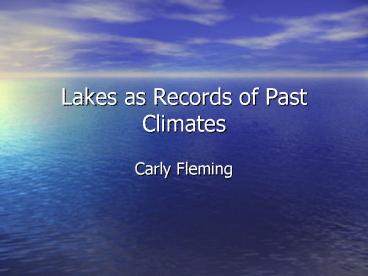Lakes as Records of Past Climates - PowerPoint PPT Presentation
1 / 22
Title:
Lakes as Records of Past Climates
Description:
Increase in Chironomid abundance and diversity that is related to increased lake ... determinants of algal and chironomid community change than were climatic factors ... – PowerPoint PPT presentation
Number of Views:51
Avg rating:3.0/5.0
Title: Lakes as Records of Past Climates
1
Lakes as Records of Past Climates
- Carly Fleming
2
What is Paleolimnology?
- A scientific subdisipline concerned with
reconstructing the past environments of inland
waters
3
Why is it Interesting?
- Can learn about past environments
- Can tell us about the impact of climate change
and human impacts on lake ecosystems - Can see the difference between human impacts and
natural processes
4
How is it Done?
- Studies usually based on the analysis of sediment
cores - Physical
- Chemical
- Mineralogical
- Biological
5
Important Biological Indicators
- Diatoms
- -good indicators of water quality and respond
rapidly to environmental changes - -well perserved in sediments
6
Climate-Driven Regime Shifts in the Biological
Communities of Arctic Lakes
- Within the last 150 years
- Warming will have greater effect on poles
- -glacier retreat
- -sea ice thinning
- -permafrost degradation
7
Methods
- 55 sediment cores taken from 48 lakes in
circumpolar arctic - Primary paleoindicators Diatoms, Chrysophytes,
Ciadocerans, Chironomids - -provide reliable records of changes in water
quality, habitat, and catchment processes - Obtained sediments with gravity corers
- samples ages determined by 210 Pb dating
- estimate species turnover in the last 150 years
8
Results
- Lengthening of the summer growing season
- Longer ice free periods
- Wider habitat range
- Higher primary productivity
- Increased thermal stratification
9
Results
- Change in Diatom life history Diatoms shifted
from benthic to littoral taxa - Planktonic diatoms (cyclotella)
- Knocked out other species who are associated with
cold conditions and ice cover (benthic
fragilaria)
10
Results
- Responses transferred to higher trophic levels
- Increase in Chironomid abundance and diversity
that is related to increased lake productivity - Cladoceran microfossils reveal changes toward
communities dominated by plankonic species
(expected response to climate warming)
11
Results
- Where there was no real change in climate
records, no real change in diatoms - eg) Northern Quebec and Labrador
12
Location
13
Summary
- Large-scale ecological reorganizations or regime
shifts, have occurred in many arctic lakes and
these changes are seen at several trophic levels - widespread species changes and ecological
reorganizations in algae and invertebrate
communities since 1850 - Remote northern ecosystems have already been
affected by human activities - -not too many more opportunities to study
arctic lakes unaffected by humans
14
Effects of Agriculture, Urbanization, and Climate
on Water Quality in the Northern Great Plains
- Problem Lake eutrophication
- Purpose To determine factors that regulate water
quality
15
(No Transcript)
16
Qu Appelle Valley
- Drainage system provides water to a third of the
population of the Canadian Great Plains - Poor water quality, excess plant growth, periodic
fish kills - Compare climate, resource use and urbanizations
as controls of aquatic ecosystems
17
Methods
- fossil algae (diatoms, pigments), invertebrates
(chironomids) analyzed in Pasqua Lake - Annual records of 83 environmental variables
(1890-1994) - Historical records of agricutural activity
- Records of urban populations in Regina and Moose
Jaw
18
(No Transcript)
19
(No Transcript)
20
Biological assemblages in Pasqua Lake
- Pre-agriculture (1776-1890) Eutrophic, had
cyanobacterial carotenoids, eutrophic diatoms,
and anoxia-tolerant chironomids - Land settlement elevated algal biomass, nuisance
cyanobacteria, and low abundance of deep-water
zoobenthos
21
Summary
- Resource use most important for changes in fossil
diatoms and pigments - Resource use and urbanization were stronger
determinants of algal and chironomid community
change than were climatic factors - urban impacts declined with distance from point
sources so management strategies will vary with
lake position within the catchment
22
References
- Hall, R.I. (1999). Effects of agriculture,
urbanization, and climate on water quality in the
northern Great Plains. Limnology and Oceanography
44 739. - Smol, J. P. et al. (2005) Climate-driven regime
shifts in the biological communities of arctic
lakes. Proceedings of the National Academy of
Sciences of the United States of America, 102,
4397-4402 - Racki, G. and Cordey, F. (2000). Radiolarian
palaeoecology and radiolarites is the present
the key to the past? Earth-Science Reviews 52,
83-120 - Whiteside. M. C. 1983. The mythical concept of
eutrophication. Hydrobiologia 103, 107-111






























